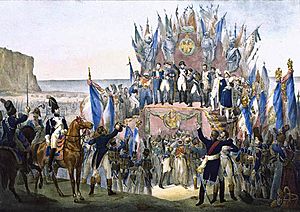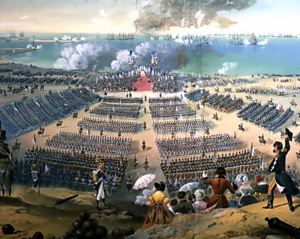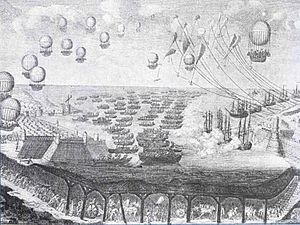Napoleon's planned invasion of the United Kingdom facts for kids
Quick facts for kids Napoleon's invasion of the United Kingdom |
|||||||
|---|---|---|---|---|---|---|---|
| Part of the War of the Third Coalition | |||||||
 Napoleon distributing the first Imperial Légion d'honneur at the Boulogne camps, on August 16, 1804, Charles Etienne Pierre Motte |
|||||||
|
|||||||
| Belligerents | |||||||
| Commanders and leaders | |||||||
| Casualties and losses | |||||||
| Many men were lost on the Boulogne flotilla during preparations | None | ||||||
Napoleon planned to invade the United Kingdom at the start of the War of the Third Coalition. Even though this invasion never happened, it greatly influenced how the British navy planned its defenses. It also led to many new forts being built along the coast of southeast England.
France had tried to invade Ireland before, in 1796. Their goal was to cause problems for the United Kingdom or use Ireland as a step to reach Great Britain. In 1798, the first French Army of England gathered on the English Channel coast. But Napoleon put the invasion of England aside to focus on campaigns in Egypt and against Austria. The plan was completely stopped in 1802 with the Peace of Amiens.
Building on earlier invasion plans from 1744, 1759, and 1779, preparations started again in 1803. This was soon after the war began. The invasion was finally called off in 1805, before the famous Battle of Trafalgar.
Contents
French Preparations for Invasion
From 1803 to 1805, a new army of 200,000 men was formed. It was called the Armée des côtes de l'Océan (Army of the Ocean Coasts) or the Armée d'Angleterre (Army of England). These soldiers trained at camps in Boulogne, Bruges, and Montreuil.
A large fleet of invasion barges, called the "National Flotilla," was built. These barges were made in Channel ports along the coasts of France and the Netherlands. The Netherlands was then controlled by France and known as the Batavian Republic. The barges were gathered at Boulogne.
The flotilla was first led by Eustache Bruix, a strong leader. But he had to return to Paris and died in March 1805. The part of the flotilla built by the Batavian Navy was led by Vice-Admiral Carel Hendrik Ver Huell. He moved the Batavian flotilla from Vlissingen to Boulogne. He did this even though the British tried to stop him in battles like the Battle of Blanc-Nez and Gris-Nez.
Port facilities at Boulogne were improved, even though the tides there made it a difficult place for such a large fleet. Forts were also built. To keep the waiting troops from getting bored or unhappy, they trained constantly. Napoleon himself often visited them for ceremonies. During one visit, he gave out the first ever Imperial Légion d'honneur, a special award.
A medal was made and a triumphal column was built at Boulogne. These were to celebrate the invasion's expected success. However, Napoleon ordered a large test of the invasion boats. The weather was rough, and his naval commanders, like Charles René Magon de Médine, advised against it. The test showed that the boats were not built well for the job. Many men were lost, even though Napoleon helped with rescue efforts himself.
Napoleon also thought about using a fleet of balloons to carry troops. He even appointed Marie Madeline Sophie Blanchard as an air service chief. However, she said the air invasion would fail because of the winds. France had used its first military balloon in 1794. Even though an air invasion didn't happen, the idea excited the British public and media.
These preparations were paid for by the Louisiana Purchase in 1803. In this deal, France sold its huge North American lands to the United States. In return, France received 50 million French francs (about $11,250,000). All of this money was spent on the planned invasion. The United States partly paid for the purchase with a loan from Baring Brothers, a British bank. This meant that the British were actually helping to pay for an invasion of their own country!
For his planned invasion of Ireland, Napoleon formed an Irish Legion in 1803. This was to be a local part of his 20,000-man Corps d'Irelande.
British Defenses Against Invasion
Even though the French boat test failed, Britain remained on high alert. The French fleet and army camps at Boulogne could be seen from the south coast of England. To fight the invasion threat, Martello towers were built along the English coast. These were small, round forts with thick walls. Local armies, called militias, were also formed.
In areas closest to France, new forts were built. Older forts, started against the 1779 invasion, were finished or improved. Dover Castle had tunnels added to hold more troops. The Dover Western Heights were built, including a Grand Shaft. This shaft allowed troops to move quickly from the hilltop fort to sea level if an enemy landed. The Royal Military Canal was dug to slow down Napoleon's army if they landed on Romney Marsh.
Rumors spread through newspapers about a huge flat French invasion raft. People heard it would be powered by windmills and paddle-wheels. There were also stories of a secret tunnel under the Channel and an invasion fleet of balloons. Newspapers also printed funny cartoons making fun of the idea of an invasion.
The British navy also launched a naval raid on Boulogne in October 1804. British fleets continued to blockade French and Spanish ships. These enemy ships were needed for France to control the sea long enough for a crossing.
Before the French invasion fleet could cross, Napoleon needed to control the English Channel. He famously said, "Let us be masters of the Channel for six hours and we are masters of the world."
His plan was for the French and Spanish fleets at Brest and Toulon to break free from the British blockade. The British blockades were led by Collingwood at Brest and Nelson at Toulon. These fleets would then sail across the Atlantic Ocean to threaten the West Indies. Napoleon hoped this would draw away the Royal Navy force led by William Cornwallis that protected the Western Approaches.
Then, the Toulon and Brest fleets (led by Pierre-Charles Villeneuve and Honoré Joseph Antoine Ganteaume) would meet at Martinique. They would quickly sail back across the Atlantic to Europe. On the way, they would lose the British fleets that were chasing them. Then, they would land troops in Ireland, as France had done in 1796 and 1798. More importantly, they would defeat any parts of the Channel Fleet still in the Channel. This would give them control of the Channel. They could then protect and transport the invasion force, all before the chasing British fleets could return.
This plan showed Napoleon's usual style. It was bold and relied on fast movement and surprise. But this style worked better on land than at sea. The changing tides and winds, along with the strong British blockade, made the plan less and less practical over time.
Only the Toulon fleet managed to break out on March 29, 1805. It crossed the Atlantic but did not find the Brest fleet. So, it sailed back to Europe alone. There, it met the British force that was blockading Rochefort and Ferrol. The French fleet was defeated at the Battle of Cape Finisterre and forced back into port.
Because of this, on August 27, 1805, Napoleon changed his plans. He used the invasion army as the main part of his new army, the Grande Armée. He ordered them to leave their camps and march east to start the Ulm Campaign. So, by the time of the Battle of Trafalgar on October 21, the invasion had already been called off. This battle simply confirmed Britain's control of the Channel, rather than preventing the invasion itself. The famous quote from First Lord of the Admiralty Lord St. Vincent – "I do not say they [the French] cannot come – I only say they cannot come by sea" – turned out to be true.
Memorial
Today, the site of the Boulogne camp has a 53 meter (174 ft) high column. It is the tallest such column in France and was built in the 1850s. On top is a statue of Napoleon. Panels at the base show him giving medals of the Légion d'Honneur to his troops. The column is surrounded by railings decorated with the golden French Imperial eagle. The old arsenal from the camp is still there.
Images for kids
-
John Bull protected by the Royal Navy
-
Drop Redoubt, part of the Dover Western Heights complex
See also
- French intervention during the Irish Rebellion of 1798
- Charles François Dumouriez#Later life and death
- Operation Sea Lion, Hitler's planned invasion of the United Kingdom during World War II










